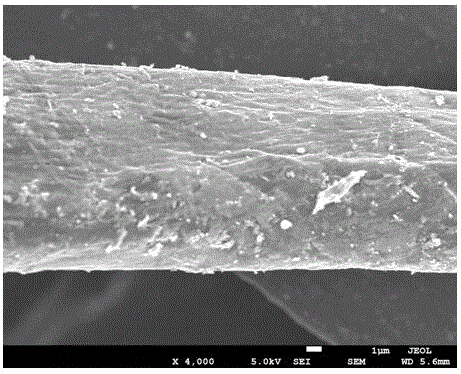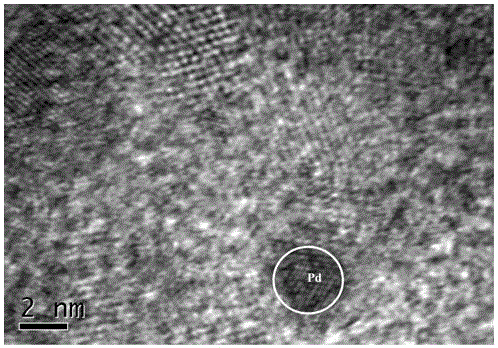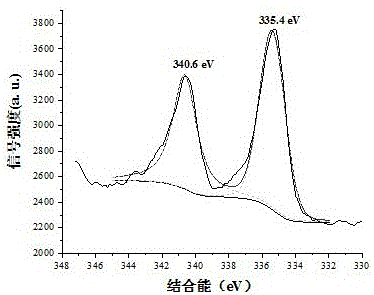Pd/TiO2/cotton fiber composite formaldehyde indoor temperature oxidation catalyst and preparation method thereof
An oxidation catalyst and cotton fiber technology, applied in the field of indoor air purification, can solve the problems of high equipment requirements, complex process, increased air resistance, etc., and achieve the effect of avoiding easy breaking, firm bonding and small air resistance
- Summary
- Abstract
- Description
- Claims
- Application Information
AI Technical Summary
Problems solved by technology
Method used
Image
Examples
Embodiment 1
[0029] (1) First, dissolve butyl titanate in absolute ethanol, add acetylacetone, stir to form a transparent solution, then add dropwise to an acidic (pH=2) aqueous solution containing 0.01% PVA, and stir for 6 days to obtain a stable solution TiO 2 Sol, wherein the molar ratio of water, absolute ethanol, acetylacetone and butyl titanate is =100:2:0.5:0.5;
[0030] (2) Soak absorbent cotton in TiO 2 In the sol, the soaking time is 5min, in which cotton and TiO 2 The mass ratio is 1:2.6; after being separated by the filter, first dry at 60°C for 5 minutes, then at 115°C for 30 minutes, and repeat the above process twice, the final drying temperature is 60°C, and the drying time is 12h. Get TiO 2 / Cotton fiber composite base material.
[0031] (3) add complexing agent trisodium citrate in the palladium nitrate solution again, stir well, the TiO obtained in the step (2) 2 / Cotton fiber composite base material is dispersed in the above-mentioned mixed solution and soaked for...
Embodiment 2
[0034] (1) First, dissolve butyl titanate in absolute ethanol, add acetylacetone, stir to form a transparent solution, then add dropwise to an acidic (pH=2) aqueous solution containing 0.01% PVA, and stir for 6 days to obtain a stable solution TiO 2 Sol, wherein the molar ratio of water, acid, absolute ethanol, acetylacetone and butyl titanate is =100:2:0.1:0.1;
[0035] (2) Soak absorbent cotton in TiO 2 In the sol, the soaking time is 5min, in which cotton and TiO 2 The mass ratio is 1:2. After being separated by the filter screen, first dry at 60°C for 5 minutes, then at 110°C for 40 minutes, and repeat the above process twice. The last drying temperature is 60°C, and the drying time is 12 hours. Get TiO 2 / Cotton fiber composite base material.
[0036] (3) add complexing agent trisodium citrate in the palladium nitrate solution again, stir well, the TiO obtained in the step (2) 2 / Cotton fiber composite base material is dispersed in the above-mentioned mixed solution...
Embodiment 3
[0038] (1) First, dissolve butyl titanate in absolute ethanol, add acetylacetone, stir to form a transparent solution, then add dropwise to an acidic (pH=2) aqueous solution containing 0.01% PVA, and stir for 6 days to obtain a stable solution TiO 2 Sol, wherein the molar ratio of water, absolute ethanol, acetylacetone and butyl titanate is =100:2:0.5:0.5;
[0039] (2) Soak absorbent cotton in TiO 2 In the sol, the soaking time is 10min, in which cotton and TiO 2 The mass ratio of TiO is 1:3. After being separated by the filter screen, the drying time is 10h at 80°C to obtain TiO 2 / Cotton fiber composite base material;
[0040] (3) add complexing agent trisodium citrate in the palladium nitrate solution again, stir well, the TiO obtained in the step (2) 2 / Cotton fiber composite base material is dispersed in the above-mentioned mixed solution and soaked for 5min, wherein palladium nitrate is relative to TiO in terms of palladium 2 The quality of / cotton fiber composite b...
PUM
| Property | Measurement | Unit |
|---|---|---|
| Particle size | aaaaa | aaaaa |
| Particle size | aaaaa | aaaaa |
Abstract
Description
Claims
Application Information
 Login to View More
Login to View More - R&D
- Intellectual Property
- Life Sciences
- Materials
- Tech Scout
- Unparalleled Data Quality
- Higher Quality Content
- 60% Fewer Hallucinations
Browse by: Latest US Patents, China's latest patents, Technical Efficacy Thesaurus, Application Domain, Technology Topic, Popular Technical Reports.
© 2025 PatSnap. All rights reserved.Legal|Privacy policy|Modern Slavery Act Transparency Statement|Sitemap|About US| Contact US: help@patsnap.com



